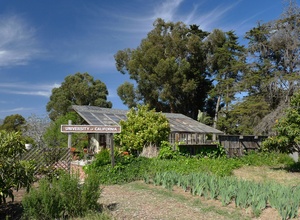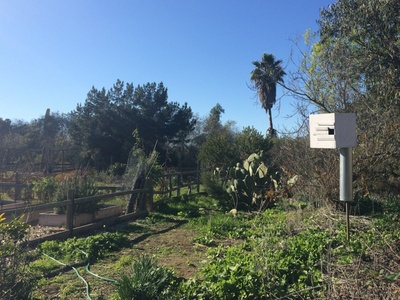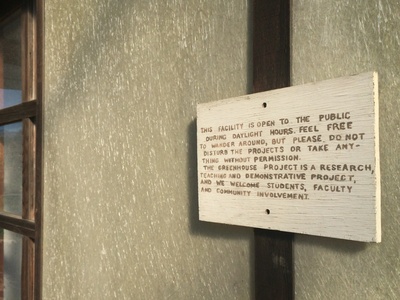 Sign near the entrance. January 2015, by Britta Gustafson (CC BY-SA).
Sign near the entrance. January 2015, by Britta Gustafson (CC BY-SA). Inside the greenhouse, with cat. January 2015, by Britta Gustafson (CC BY-SA).
Inside the greenhouse, with cat. January 2015, by Britta Gustafson (CC BY-SA).
 April 2009, by Ryosuke Yagi (compose-r) (CC BY)The UCSB Greenhouse and Garden Project is a community garden on a patch of land just west of Harder Stadium, north of the stadium parking lot and near Los Carneros Road. The land is subdivided into small patches which are leased out to individuals or groups in order to grow the plants.
April 2009, by Ryosuke Yagi (compose-r) (CC BY)The UCSB Greenhouse and Garden Project is a community garden on a patch of land just west of Harder Stadium, north of the stadium parking lot and near Los Carneros Road. The land is subdivided into small patches which are leased out to individuals or groups in order to grow the plants.
Because the gardens have been here for some years, a plant or tree from a previous tenant will pass to the new tenant. This includes many fruit trees and a variety of other less woody but equally long term vegetation. These include apples and oranges of many varieties, figs, kumquats and even a very large mulberry tree that provides a great number of fruit through the summer months. The mulberry tree is not in a plot and is nestled toward the far end of gardens near Los Carneros (and it produces delicious fruit in the summer). There are stands of hops growing on one of the trellises, an American variety, perhaps a Sterling. They tend to have a high alpha acid which is good for American style IPAs. Tobacco and artichoke grows wild in a few places as well.
The plots are irregular and sometimes have odd shapes. There is a greenhouse which is maintained by the custodians of the garden and may house the cat that resides in the garden assisting in pest control. Besides rats, other animals such as rabbits, gophers and voles live in the garden and benefit from the produce. In many cases people have tried to put in fencing around their plot to prevent the burrowing animals from digging their way in, in most cases to no avail - the teeth of most rodents and lagomorphs being keenly suited for chewing through even the toughest barriers, allows them to breach even a buried layer of chicken wire.
Access to the gardens is via the driveway to Harder Stadium, off Stadium Way, or via foot from Los Carneros. From the driveway, drive to the parking lot and turn right onto the dirt road that parallels the lot. At the end on the right you will find several buildings including the greenhouse and the entrance to the gardens. Alternatively you can park in the lot and walk to the gardens.
History
On a page with a couple of aerial photos of the garden, a comment says "That is the Greenhouse & Garden Project at UCSB and CCBER's native plant nursery for habitat restoration on campus. The GHGP moved to that location (where an old Storke Ranch foundation is) in 1980 after having been located where Santa Ynez Apartments are located now. Before then, there was a small garden with a geodesic dome greenhouse and chickens where the Events Center is now located."
A description of a talk about food at UCSB says "The UCSB campus organic garden has existed for over 40 years—currently as the Greenhouse and Garden Project (GGP), 5 acres west of Harder Stadium. It has had to struggle for existence at times because its importance has not been appreciated. The GGP has the potential to link UCSB to the local and global agricultural and food community."
An article from 2005 about the part of the garden used for teaching UCSB classes, "UCSB Gardens, Greenhouse a Cornucopia of Experiences", says "Surrounding the greenhouse, which was raised in the early 1980s on the foundations of a former Storke Ranch structure, are the members’ 40 plots, few of which conform to orderly areas."
Photos
 Garden plot using recycled sign (see Local Politicians). January 2015, by Britta Gustafson (CC BY-SA).
Garden plot using recycled sign (see Local Politicians). January 2015, by Britta Gustafson (CC BY-SA). Fruit tree in the garden, maybe a guava or loquat tree. January 2015, by Britta Gustafson (CC BY-SA).
Fruit tree in the garden, maybe a guava or loquat tree. January 2015, by Britta Gustafson (CC BY-SA).
 Flowers in the garden. January 2015, by Britta Gustafson (CC BY-SA).
Flowers in the garden. January 2015, by Britta Gustafson (CC BY-SA). Possibly a birdhouse. January 2015, by Britta Gustafson (CC BY-SA).
Possibly a birdhouse. January 2015, by Britta Gustafson (CC BY-SA).
 Lemon tree with greenhouse. January 2015, by Britta Gustafson (CC BY-SA).
Lemon tree with greenhouse. January 2015, by Britta Gustafson (CC BY-SA). Classroom area outside greenhouse. January 2015, by Britta Gustafson (CC BY-SA).
Classroom area outside greenhouse. January 2015, by Britta Gustafson (CC BY-SA).

 On the little patio. January 2015, by Britta Gustafson (CC BY-SA).
On the little patio. January 2015, by Britta Gustafson (CC BY-SA).
 Sign on greenhouse, "open to the public during daylight hours". January 2015, by Britta Gustafson (CC BY-SA).
Sign on greenhouse, "open to the public during daylight hours". January 2015, by Britta Gustafson (CC BY-SA). Sign inside greenhouse, "designed to stay warm in the winter and cool in the summer". January 2015, by Britta Gustafson (CC BY-SA).
Sign inside greenhouse, "designed to stay warm in the winter and cool in the summer". January 2015, by Britta Gustafson (CC BY-SA).
Links
- Greenhouse and Garden Project website, including photos of the garden and contact information for staff.
- Photos of a couple of the cats there.
- "The giant organic pumpkin that Bill grew at the UCSB Greenhouse & Garden Project in 2000"
- "Check out what an asparagus plant looks like when it's sprouted! Learned a new thing from Greenhouse & Garden Project"


